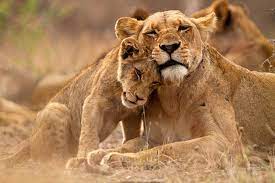For most safari goers, the key objective is to see the ‘Big Five”: rhinos, elephants, buffalo, lions, and leopards. Hunters coined this phrase in the 1800s, but today it refers to the ideal safari experience. Well, as long as you remember to be responsible while looking at the wildlife, respecting their space and habitat.
The Big Five: Background
This phrase is used to refer to the African Elephant (Loxodonta africana), the African Buffalo (Syncerus caffer), the African Leopard (Panthera pardus pardus), the African Lion (Panthera leo), and the African Rhinoceros (Ceratotherium simum). These animals have been popular since the time of explorers and hunters like Ernest Hemingway. They also have special meaning for many cultures in Africa.
African Elephant
African elephants are iconic members of the natural world due to their impressive size, often reaching heights of up to three meters at the shoulder or more. They inhabit savanna grasslands across sub-Saharan Africa but tend to move around frequently according to seasonal conditions. Kruger safari packages in South Africa, Chobe National Park tours in Botswana, and tours in Addo Elephant National Park are all excellent options for spotting these majestic creatures.
African Buffalo
Buffalo are powerful ungulates with solid, muscular bodies covered with distinctly curved horns, which can reach up to 60 inches wide on either side of their heads. They typically prefer areas rich with woodland savannas and grassland habitats where they can roam freely over large distances and find plenty of vegetation to feed on during dry season periods.
The Serengeti National Park in Tanzania, the Masai Mara National Reserve across Kenya’s border into Tanzania, and Hwange National Park in Zimbabwe are great spots for buffalo sightings. When tracking buffalo, it can be useful not just to observe from a car window but also to get out and explore carefully near bodies of water or areas dense with shrubs or trees, as buffaloes like hiding away from sight.
African Leopard
Leopards may sometimes appear close yet remain elusive due to their tendency for stealthy movement through thick bushveld areas at night under cover of darkness. Leopards display highly distinct characteristics, such as spotted coats patterned with thin tawny rosettes that blend perfectly with their surroundings.
Their home ranges may vary considerably depending upon the availability of prey between different regions; however, Sabi Sands Game Reserve on the border of South Africa and Mpumalanga, Mozambique, Samburu Reserve in northern central Kenya along the Ewaso Ng’iro river valley, and South Luangwa in Zambia are known as prime hotspots for leopard sightings. When trying to spot a leopard, the best practice is scouting remote areas for chances of undisturbed behaviour while keeping a safe distance to ensure respect for nature and the environment.
African Lion
Some great spots to see lions are Ngorongoro Crater in Tanzania, the Karoo region, and the border of Botswana. When you’re outdoors in the field waiting to see this majestic animal, it’s important to have patience, maintain a respectful distance, keep safe, and seek assistance from a qualified ground guide or spotter. This ensures resources are not spent in the wrong directions whilst observing a pride in action, capturing and cherishing the moment for a lifetime!
Black and White Rhino
There are two rhino species: black rhinos (Diceros bicornis) and white rhinos (Ceratotherium simum). They are distinguished by their size, slightly different shapes, and their uniquely shaped horns. These rhinos are mainly found in the southern Sahara desert climate, ranging from Ethiopia to Angola in the east, Zambia to Namibia in the west, with significant numbers spread across Etosha in Namibia, Lewa Wildlife Conservancy in the Central Highlands of the Kenyan Valley surrounding Mt. Kenya, and Mkhaya Game Reserve in Eswatini’s hilly, low-lying terrain.
Black rhinos are found in East Africa. Varying degrees of encroachment by human activity have caused drastic declines and have nearly wiped them out in some places. Though numbers have increased in recent years due to conservation efforts, both species remain endangered.
When heading out for a safari in Africa, you have the chance to spot some of the continent’s most iconic creatures: the Big Five. To make the most of your safari adventure, take the time to research and plan which national parks and reserves you visit, adhere to safety protocols once there, practice responsible tourism, and be patient. With careful preparation, your trip has the potential to be an unforgettable experience that serves as a reminder of nature’s beauty and importance.







